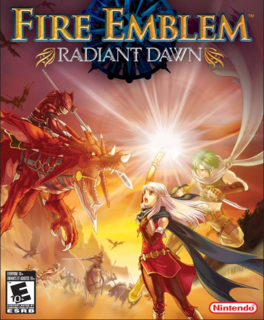i can play for 24 hours this game, but i cant pass the medium level this game is simple and easy to understand, the best
What you won't get with Fire Emblem, however, is any motion control or IR experience. There's no Mii integration, no online, no waggle, and no IR aiming. It is what it is, and Fire Emblem plays identical to its GameCube counterpart, who in turn still drew inspiration from the very beginning nearly two decades ago. The downside to that? Fire Emblem inherently feels like a GameCube title, with nearly identical interface, style, graphics, audio (or lack of), pacing, and general appearance, so while the game may come in a white box and burned onto a DVD, it's about as far from a traditional Wii experience as you can get. In fact, chances are if you already know you want this game before reading our review, as Fire Emblem hits a very specific, mature, traditional crowd.
Fire Emblem: Radiant Dawn is a direct sequel to last generation's Path of Radiance on GameCube. Players will eventually take control of nearly every character from the last game, work within the same world, but now see a totally different side of the story. After the defeat of Mad King Ashnard three years ago, the country of Daein is now falling to pieces, as a corrupt government strives to keep control over a public body that is now thrown into chaos. As an odd move for Radiant Dawn, players are actually assuming the role of members of Daein, previously the enemy in Path of Radiance. Taking control of a group called the Dawn Brigade - a medieval Rebel Alliance, if you will - players will scour the countryside in search for allies, aiming to take down the corrupt leadership that has - and continues - to plague Daein. And while this is a 100% sequel to the last game, players that haven't had a chance to pick up Path of Radiance for GameCube won't be left in the dust, as you'll get tons of backstory, character reintroduction, and an all new story. Basically if you just read the preceding paragraph, you're already good to go. Corrupt government, group of rebels, you with a controller… go.
Battle movement and strategy revolves around the same staples the series has since the beginning, with all control being done turn-based around a huge grid. As with Advance Wars, each unit has different attack abilities, movement space, and ranged or local attacks. What will come to a surprise for many, however, is that this is a game that embraces "permadeath", so any unit that falls in battle is gone, and gone forever. This means you'll either need to plan ahead, or restart battles often if you want to make it through the game. We've got absolutely no problem wit the game's difficulty or traditional rules, as it's exactly how Fire Emblem has been for years and years; just know what you're getting into.
It's not all wonderful nostalgia and flawless packaging though, as there are a few things Fire Emblem is definitely missing, and they can be very, very annoying. For starters 99% of the storytelling in the game is done with static drawings placed over a painted background. When characters interact, text scrolls by with no VO to be had. There are sections in the game - many more this time around than on GameCube - that launch FMV sequences which of course support full voice acting, and the actors this time around do a wonderful job; it's just a shame they couldn't be used for the entirety of the story. What you end up getting is an experience nearly identical to what you could see on Nintendo DS, minus the FMV work, and it's one that Nintendo seems to have no intention on improving. In fact, the general amount of animation in the game is extremely small, with short scripted sequences launching whenever attacks are initiated, but the majority of the game working with sliding pieces and very simple animations on tiny, low-poly characters. If you pick this one up, you better be in it for the gameplay, as the overall presentation - both audio and visual - is astonishingly simple.

